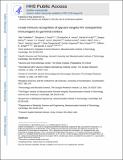| dc.contributor.author | Tokatlian, Talar | |
| dc.contributor.author | Read, Benjamin J. | |
| dc.contributor.author | Jones, Christopher A. | |
| dc.contributor.author | Kulp, Daniel W. | |
| dc.contributor.author | Menis, Sergey | |
| dc.contributor.author | Chang, Jason Y. H. | |
| dc.contributor.author | Steichen, Jon M. | |
| dc.contributor.author | Kumari, Sudha | |
| dc.contributor.author | Allen, Joel D. | |
| dc.contributor.author | Dane, Eric L. | |
| dc.contributor.author | Liguori, Alessia | |
| dc.contributor.author | Sangesland, Maya | |
| dc.contributor.author | Lingwood, Daniel | |
| dc.contributor.author | Crispin, Max | |
| dc.contributor.author | Schief, William R. | |
| dc.contributor.author | Irvine, Darrell J | |
| dc.date.accessioned | 2020-07-17T20:29:08Z | |
| dc.date.available | 2020-07-17T20:29:08Z | |
| dc.date.issued | 2019-02 | |
| dc.date.submitted | 2018-06 | |
| dc.identifier.issn | 0036-8075 | |
| dc.identifier.issn | 1095-9203 | |
| dc.identifier.uri | https://hdl.handle.net/1721.1/126252 | |
| dc.description.abstract | In vaccine design, antigens are often arrayed in a multivalent nanoparticle form, but in vivo mechanisms underlying the enhanced immunity elicited by such vaccines remain poorly understood. We compared the fates of two different heavily glycosylated HIV antigens, a gp120-derived mini-protein and a large, stabilized envelope trimer, in protein nanoparticle or “free” forms after primary immunization. Unlike monomeric antigens, nanoparticles were rapidly shuttled to the follicular dendritic cell (FDC) network and then concentrated in germinal centers in a complement-, mannose-binding lectin (MBL)–, and immunogen glycan–dependent manner. Loss of FDC localization in MBL-deficient mice or via immunogen deglycosylation significantly affected antibody responses. These findings identify an innate immune–mediated recognition pathway promoting antibody responses to particulate antigens, with broad implications for humoral immunity and vaccine design. | en_US |
| dc.language.iso | en | |
| dc.publisher | American Association for the Advancement of Science (AAAS) | en_US |
| dc.relation.isversionof | http://dx.doi.org/10.1126/science.aat9120 | en_US |
| dc.rights | Creative Commons Attribution-Noncommercial-Share Alike | en_US |
| dc.rights.uri | http://creativecommons.org/licenses/by-nc-sa/4.0/ | en_US |
| dc.source | PMC | en_US |
| dc.title | Innate immune recognition of glycans targets HIV nanoparticle immunogens to germinal centers | en_US |
| dc.type | Article | en_US |
| dc.identifier.citation | Tokatlian, Talar et al. "Innate immune recognition of glycans targets HIV nanoparticle immunogens to germinal centers." Science 363, 6427 (February 2019): 649-654 © 2017 The Authors | en_US |
| dc.contributor.department | Harvard University--MIT Division of Health Sciences and Technology | en_US |
| dc.contributor.department | Massachusetts Institute of Technology. Department of Biological Engineering | en_US |
| dc.contributor.department | Massachusetts Institute of Technology. Department of Materials Science and Engineering | en_US |
| dc.contributor.department | Koch Institute for Integrative Cancer Research at MIT | en_US |
| dc.relation.journal | Science | en_US |
| dc.eprint.version | Author's final manuscript | en_US |
| dc.type.uri | http://purl.org/eprint/type/JournalArticle | en_US |
| eprint.status | http://purl.org/eprint/status/PeerReviewed | en_US |
| dc.date.updated | 2020-03-09T18:51:15Z | |
| dspace.date.submission | 2020-03-09T18:51:17Z | |
| mit.journal.volume | 363 | en_US |
| mit.journal.issue | 6427 | en_US |
| mit.license | OPEN_ACCESS_POLICY | |
| mit.metadata.status | Complete | |
